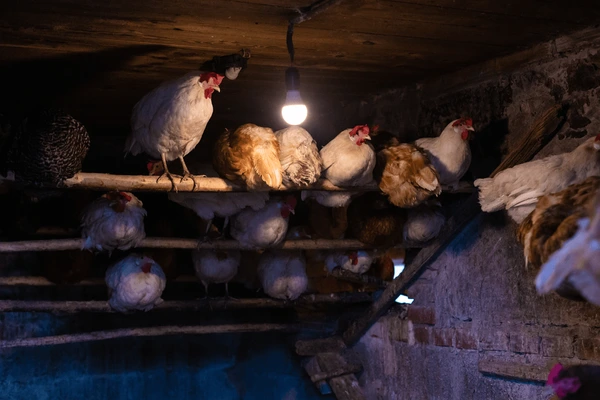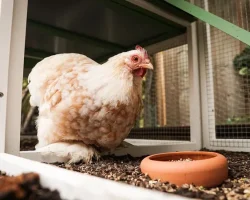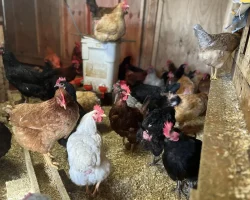Chicken lighting can make a massive difference to your coop. It’s a simple fact that your birds won’t lay as many eggs during the dark winter months. There’s a good reason for this! Winter isn’t the best time to hatch chicks so their body naturally lowers the chance of them laying eggs.
An effective chicken lighting system will solve this problem so you can continue enjoying eggs for breakfast! In this guide, I’ll walk you through everything you need to know about setting up your chicken lighting.
Chickens See Differently Than Humans Do
Don’t mistake what you see for what your chickens see! Chickens see very differently than humans do:
- Chickens see detail and movement much better than humans do
- They see more colors
- They don’t see well in the dark
- Chickens process 200 images per second, while humans only process 30
- Chickens can ‘sense’ light through their pineal gland, without needing their eyes!
Therefore, having the right chicken lighting in your coop is very important and complex. It’s not as easy as looking with your own eyes and applying what you like yourself.
Some research on what your chickens prefer is needed. Don’t worry, if you read this article you will be ahead of most hobby chicken keepers!
Why Do Chickens Need Light To Lay Eggs?
New owners will notice that their adult birds lay an egg per day in the spring and summer, before a drop-off in the winter. This is natural because laying hens require a certain day length to keep laying eggs, depending on their age and other factors. The light stimulates their pineal gland and follicle-secreting reproductive hormones, that regulate egg production.
Correct chicken lighting is key to keep ‘articifical’ day length long enough during the darker and shorter days in winter. Without it, your hens will probably stop laying.
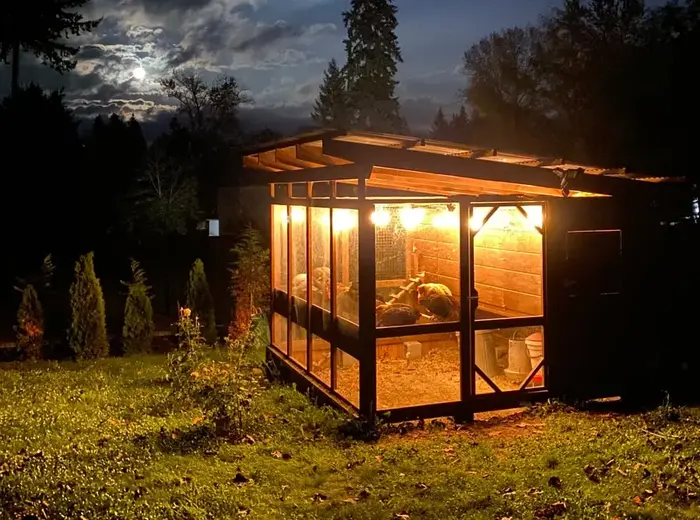
What Factors Influence Chicken Lighting Requirements?
Consider these aspects before you choose your chicken lighting. Let me take you through them briefly now.
How Old Are Your Hens?
Age is a big factor when it comes to laying eggs. Older chickens need slightly more hours of light to produce eggs than younger pullets. It’s not unusual for hens under one-year-old to continue laying eggs through winter even without artificial lighting. From experience, this is more likely if they start laying before winter properly sets in.
What Breed Are Your Chickens?
Different chicken breeds will need specific requirements. Cold hardy birds like Rhode Island Reds or Plymouth Rocks don’t need as intense lighting. Backyard coop keepers in northern US and European states might like these breeds.
Chicken Lighting Factors To Consider
You need to consider many factors to optimize your chicken lighting system:
- Light intensity
- Light duration (photoperiod)
- Light color (spectrum)
- Consistency of lighting
- Type of chicken lighting
- Position and placement of lights
- Flickering
- Heat production
By balancing these factors, you will give your hens a comfortable and cozy coop. Let’s learn more about each of them, so you can raise healthy hens that produce lots of eggs
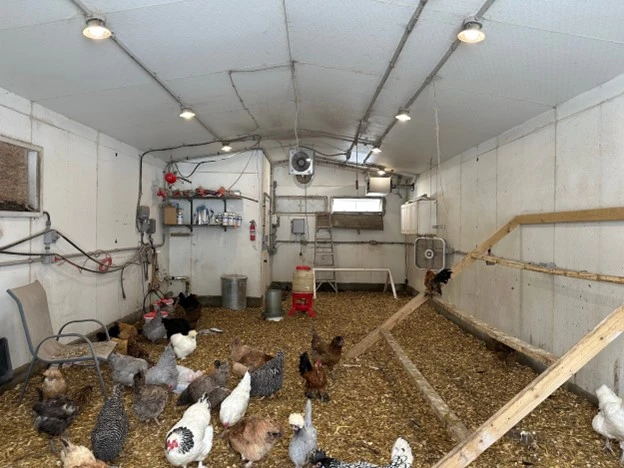
What Light Intensity Do I Need?
Chickens need a certain light intensity to see well and feel comfortable. Too much light can cause stress, while too little can affect lower egg production. Generally, around 10-20 lux (the unit of light intensity) is perfect for chickens during the day. Nighttime lighting should be minimal or absent to mimic the natural dark period. Special lux light meters are available to measure light intensity. Measure it at chicken height!
How Many Hours of Light Do Chickens Need To Lay?
The amount of time you need to use chicken lighting will depend on the age of your hens and natural day length. Typically, hens need around 14-16 hours of light per day during the laying period. Maybe you can leave your chickens outside in natural light for 8 hours per day in December or January. Then you’ll need to provide 6 hours of artificial lighting in their coop to make up the difference.
Meanwhile, laying hens do need a day-and-night rhythm. So don’t leave the lights on all night! The easiest way to solve this is to put your chicken lighting on a timer. Only for very young chicks, or meat birds, poultry farms leave the lights on for more than 20 hours a day to make sure they eat enough feed.
Discover more on how to design a chicken lighting program later in this article.
What Light Color is Best for Chickens?
Chickens respond differently to various light colors (wavelengths). White or blue light stimulates activity and egg production, while red lights are calming. In professional poultry farms, red lights are sometimes used to prevent feather pecking. For hobby chicken keepers, regular white lights will do just fine.
Consistency Of Lighting Is Key
Consistency is key. Not just for our kids, but also for our chickens. Chickens need a predictable light schedule since abrupt changes can cause stress and lower egg production. If you need to make changes, do it gradually.
Several Types of Chicken Lighting Exist
LED lights are commonly used in poultry farming because they are energy-efficient and have a long lifespan. Other types like incandescent or fluorescent lights are less efficient but still commonly used, especially in smaller operations.
Discover more about the types of chicken lighting later in this article. I also included my expert picks for the best chicken lighting.
Where To Place Chicken Lighting?
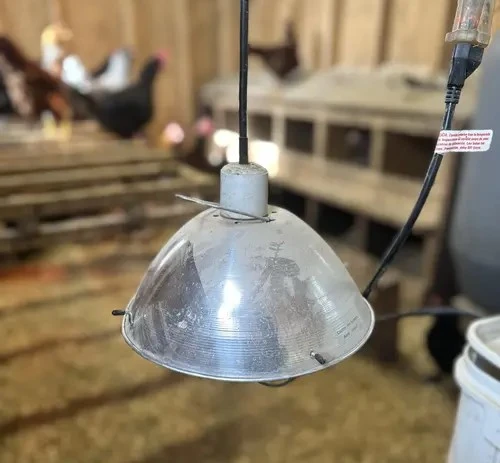
Light should be spread evenly throughout the chicken coop and run. You want to make sure that you put your chicken lighting in the right spot to maximize its effect. I advise putting it above the chickens on the ceiling if possible.
Check the amount of light at the level of the chickens, which is ground level. Try to prevent shadows and shaded areas as much as possible, except inside the nesting boxes. There, your chickens prefer darkness.
Always ensure that it’s safe for your chickens. There shouldn’t be any exposed wires because curious hens may peck them. This can be very dangerous for your birds so hire an electrician to install your system properly if you’re unsure. Also, don’t put their water underneath the bulb in case it falls and shatters!
Prevent Flickering Lights
Flickering is the (rapid) change in the light output of a lamp. It can cause stress, disrupt sleep, and lower egg production. It may even cause hens to start pecking at each other, which may result in cannibalism.
Use flicker-free lights and make sure you have a stable electrical supply to avoid flickering. Be aware that chickens see differently than we do. Lights that might not seem to flicker to you, might flicker for your chickens!
Remember that chickens see 200 images per minute while you see only 30. Therefore, it can help to use equipment to measure flickering you can’t see with your human eyes. You can use professional hand-held flicker meters, which are best but expensive. Or, measure with the camera of your smartphone. Special flickering apps are also available for a more accurate measurement.
Heat Producing Lights Are Often Less Efficient
Lighting should also account for the temperature it might generate. Incandescent lights, for example, can produce a lot of heat. On the other hand, LED lights emit very little heat, making them a safer and more energy-efficient option.
What Type of Chicken Lighting Should I use?
There are three main types of chicken lighting that most people use in their coops. Sodium vapor lamps are not used often, so they are not included in this list. Let me take you through the pros and cons of each now!
LED Lights
LEDs are a popular option because of their long lifespans and low running costs. The initial cost is more expensive but you may save money over time. LEDs aren’t as intense and they tend not to flicker like other lightbulbs. The best is to buy special flicker-free LED lights with a timer. This is good because there’s less risk of the hens suffering from stress. LED lights are great if you’re planning on keeping chickens for the long haul!
Incandescent Lighting
Most hobbyists use incandescent lighting because they are cheaper to install. It’s simple to rig up a couple of bulbs in your coop. The bonus is that they also emit heat! Keep an eye on the weather because you don’t want to overheat your birds. It’s easier to install them but they also represent a greater fire risk. Also, you may have a bigger electricity bill. I recommend incandescent lights if you’re just starting out with a couple of hens.
Fluorescent Lighting
I’m only including fluorescent lighting because I want to be thorough! This is the worst type of chicken lighting and I don’t recommend using it in your coop. One big problem is that they don’t work well in cold weather so this defeats the purpose. Furthermore, the wrong type of fluorescent lighting won’t help your chickens to lay more eggs. Only warm-white fluorescent bulbs will do the job so don’t waste time with other colors.
How To Design A Chicken Lighting Program
I get that designing a chicken lighting program may seem intimidating but it’s not that difficult!
There are 2 basic rules for chicken lighting schedules:
- Do not increase day length in rearing before the moment of light stimulation
- Do not decrease day length for laying hens
First, you need to check what is the natural day length (hours of sunlight) when your hens are about 16 weeks old. Or, in case your purchase adult laying hens, ask the seller what is their lighting schedule.
You should gradually introduce lighting because you don’t want to trigger a molt. As the days begin to shorten, increase the amount of time you leave the lights on. Then as we start to move toward spring, you can gradually decrease the lighting. This way, you are artificially keeping day length the same.
One tip is to provide artificial light in the pre-dawn hours rather than after the sun sets. This is because the chickens will naturally go to roost as daylight fades. They may stay awake if the natural light is on after this throughout the night. Chickens don’t have night vision so they may panic if their coop suddenly plunges into darkness!

Give Your Chickens A Break
Yes, we all love eating fresh eggs every day but sometimes we can have too much of a good thing! Hobby chicken keepers can use artificial lighting to regulate day length and keep their hens laying, particularly in the winter months. However, it can be a smart idea to let your hens recharge their batteries.
First, your hens may be getting older. Continuous egg production can put excess strain on their bodies. It might be better to give them a couple of months off to prolong their laying lives.
Secondly, your hens need energy to stay warm in fall and winter. In nature, laying eggs in winter has a high physical cost for chickens and the risk to their chicks. However, assuming you winterized your coop, this should not be a big issue.
Last but not least, after a break your hens often lay more or slightly larger eggs. So, a break is often good for egg production in the long run.
Does this mean no artificial lighting? Not necessarily. Commercial layer breeds can produce eggs without breaks for up to two years nowadays, though production gradually declines. If egg production drops significantly, a break may be needed.
The fall molt, when hens replace old feathers, also impacts laying. You can prevent molting by keeping the artificial day length the same. But, if they have started molting, don’t activate your chicken lighting system until they finish!
FAQS
Does Red Light Help With Egg Production?
No, red light doesn’t help your chickens lay eggs. Some experts believe that red light has a calming effect on chickens but it doesn’t impact eggs at all. However, it may stop your hens from pecking each other throughout the cold winter months. They’re not essential but some hobbyists find them useful.
Can I Always Leave My Chicken Lights On?
Don’t forget to deactivate your chicken lights! Too much light is actually counterproductive for laying eggs. The hens may show signs of stress and pluck their feathers. In the worst case, they may even fight or engage in cannibalism. The best expert tip is to set a timer and work out a daylight-saving calendar!
Do Chickens Need a Little Light at Night?
No, chickens do not need a light at night. However, it depends on what you call the ‘night’. As a chicken expert, I am not talking about the ‘real’ natural night, but the dark period. You do need lighting to extend the ‘artificial’ day length during the winter when days are shorter. During the dark period, you don’t need to turn on any lights.
Do I Need A Heater For My Chickens?
No, heating your coop is not necessary if you winterize your chicken coop well. Especially not when temperature doesn’t drop below 12°F (-10°C), and you have cold-hardy chicken breeds.
Only baby chicks and young chickens need a heater, or brooder, especially in winter. The optimum temperature of a day-old chick is 97°F (36°C), and chicks cannot regulate their body temperature yet (poikilothermic) in the first days of life. So they rely on their mother or you!
Final Thoughts
A good chicken lighting system is the best way to keep your flock comfortable and guarantee you get fresh eggs throughout winter. Setting them up is straightforward after you choose a light and work out the lighting program. I strongly advise setting a timer because this ensures you won’t leave it on for too long or forget.
After reading this article, you can now consider yourself a chicken lighting expert!

